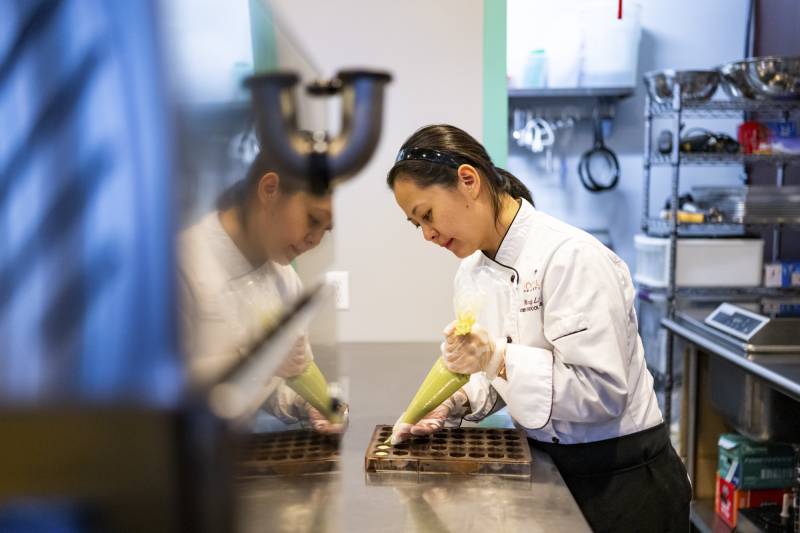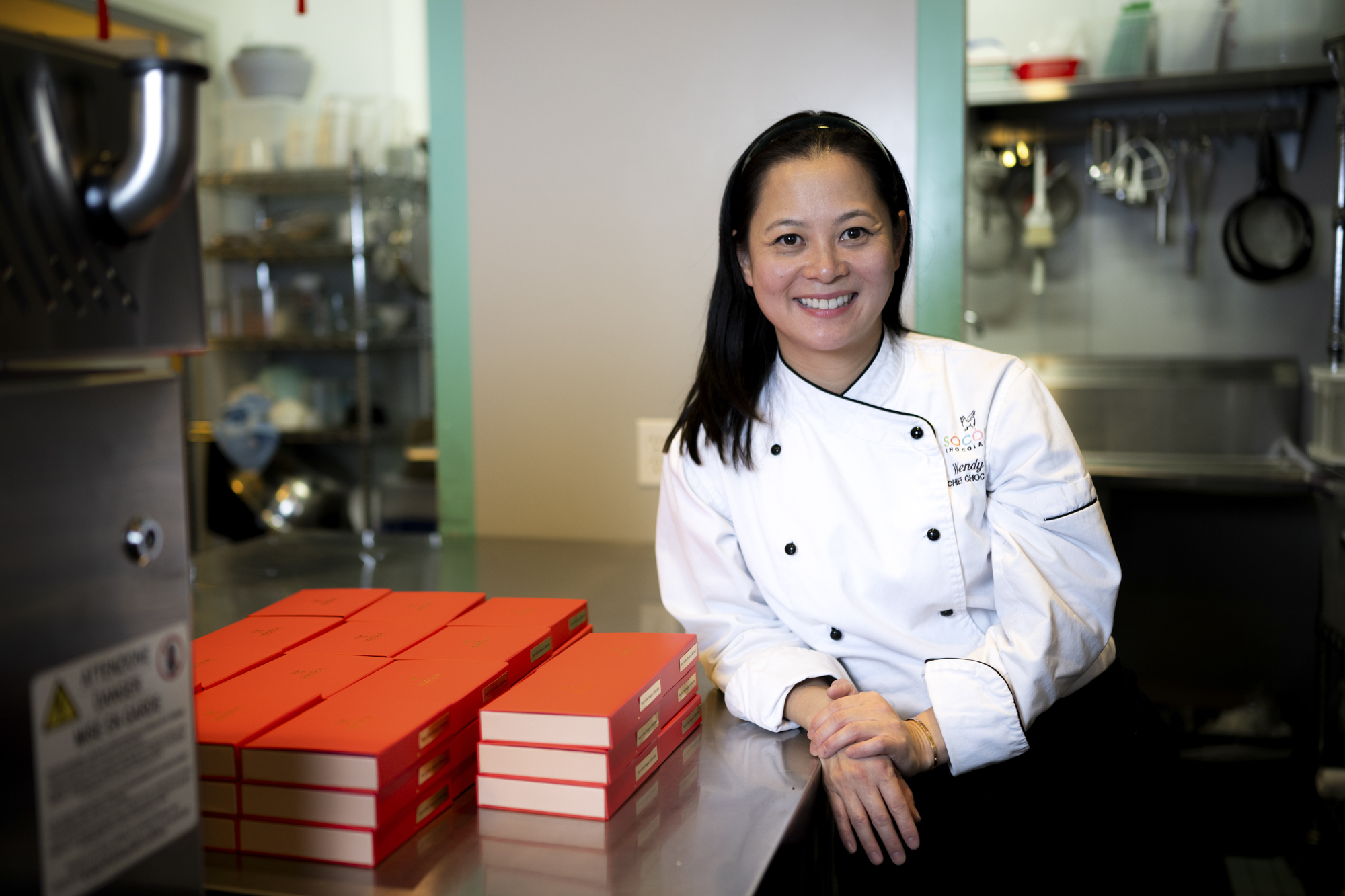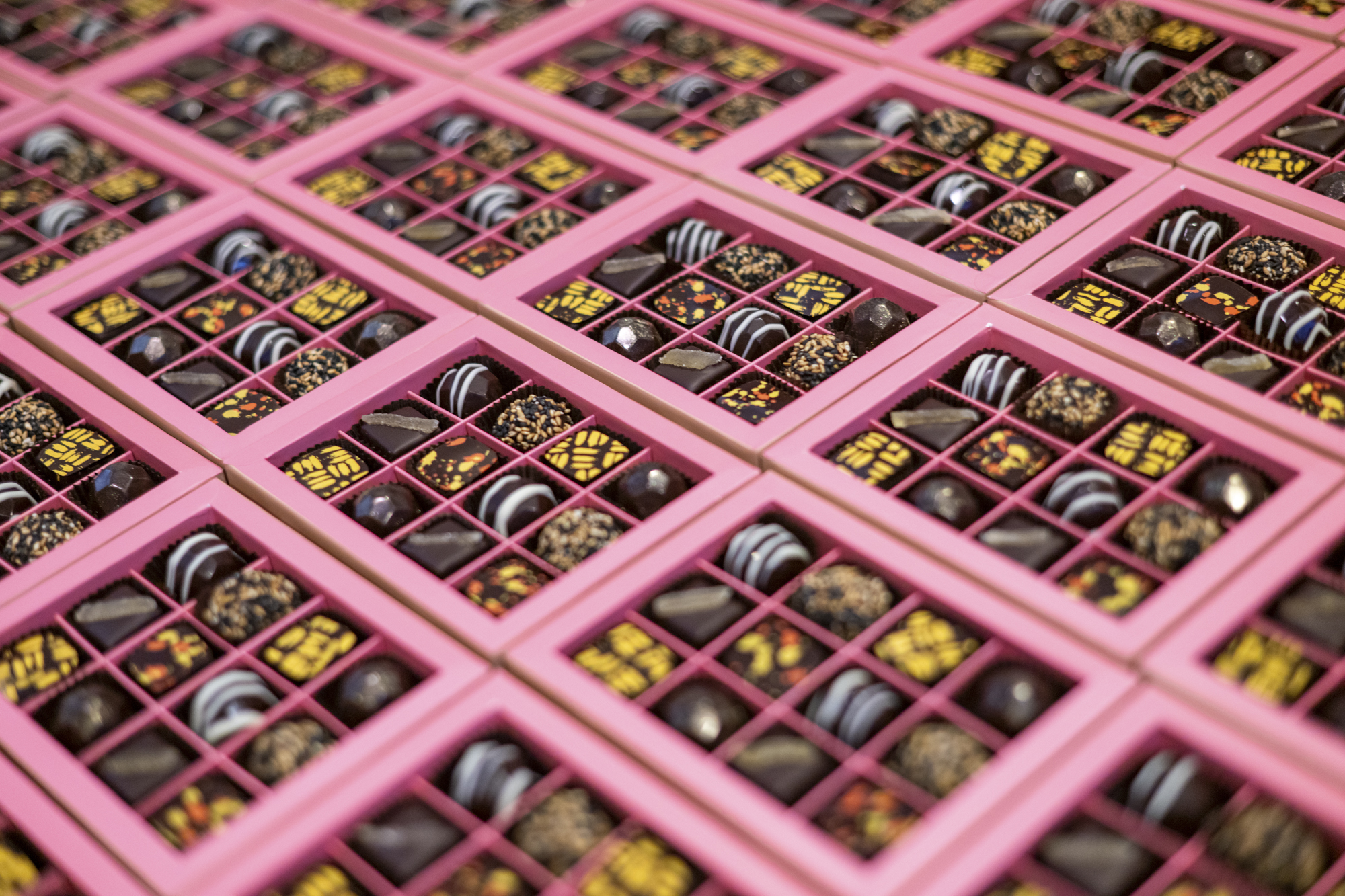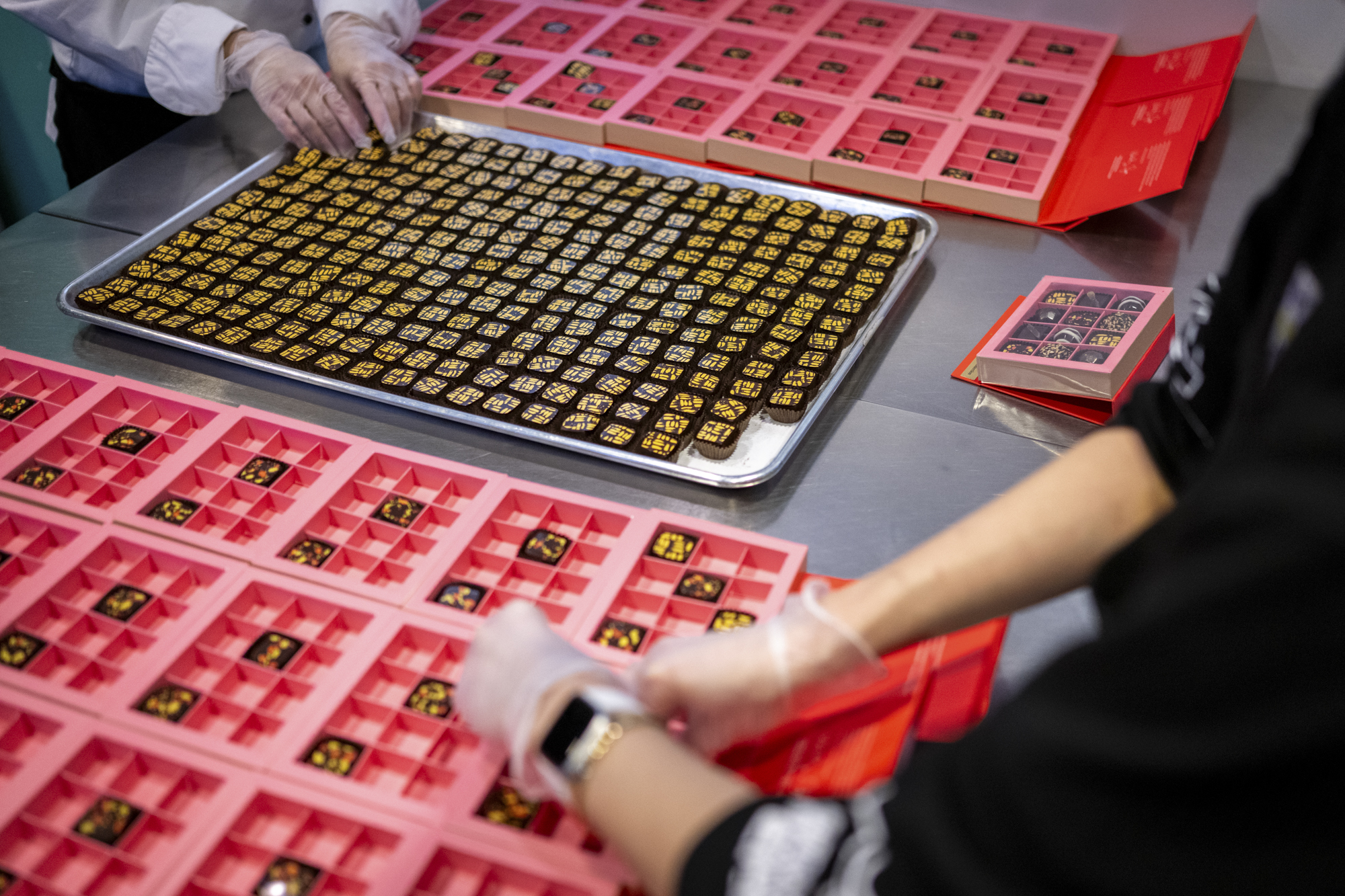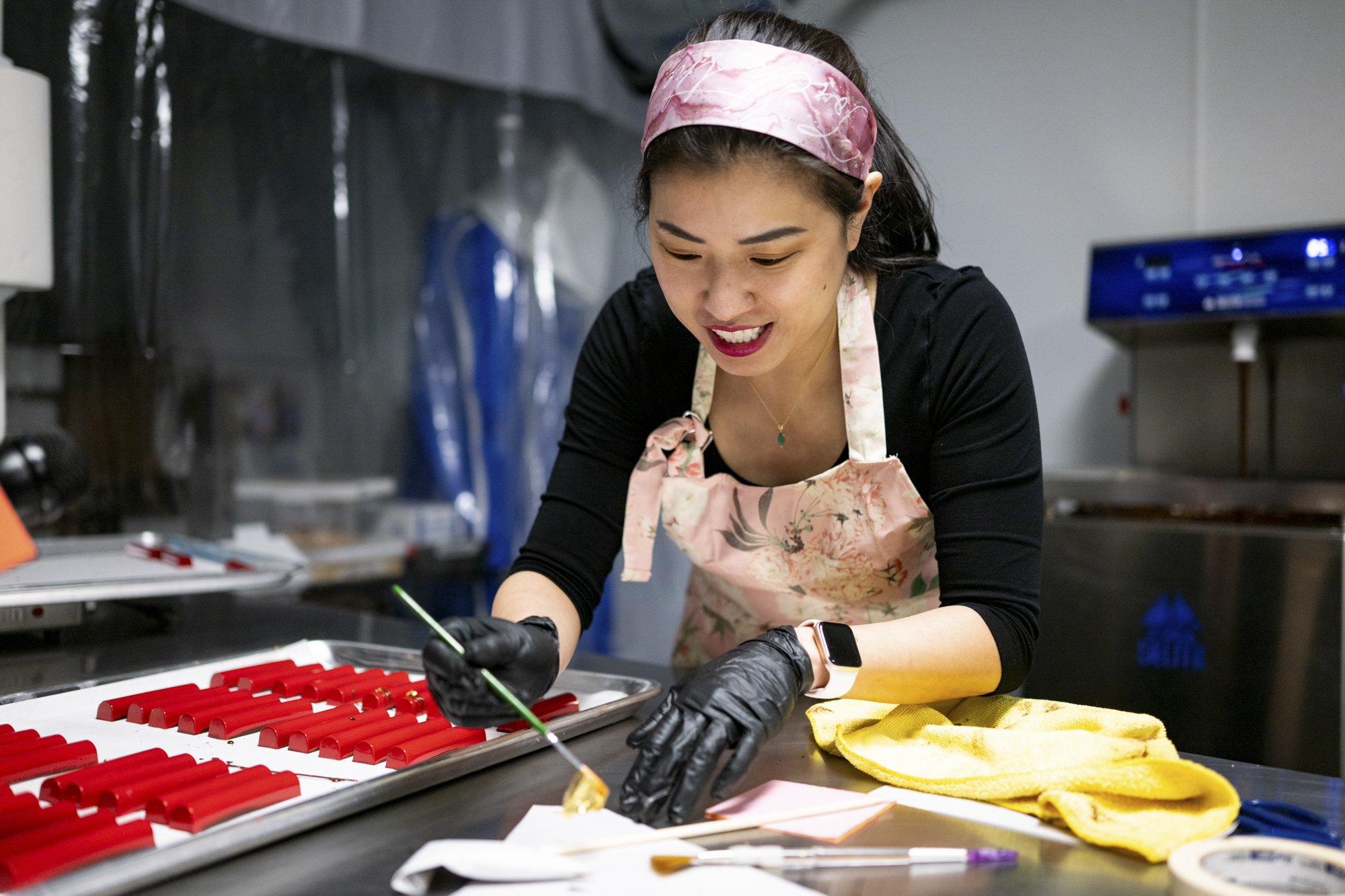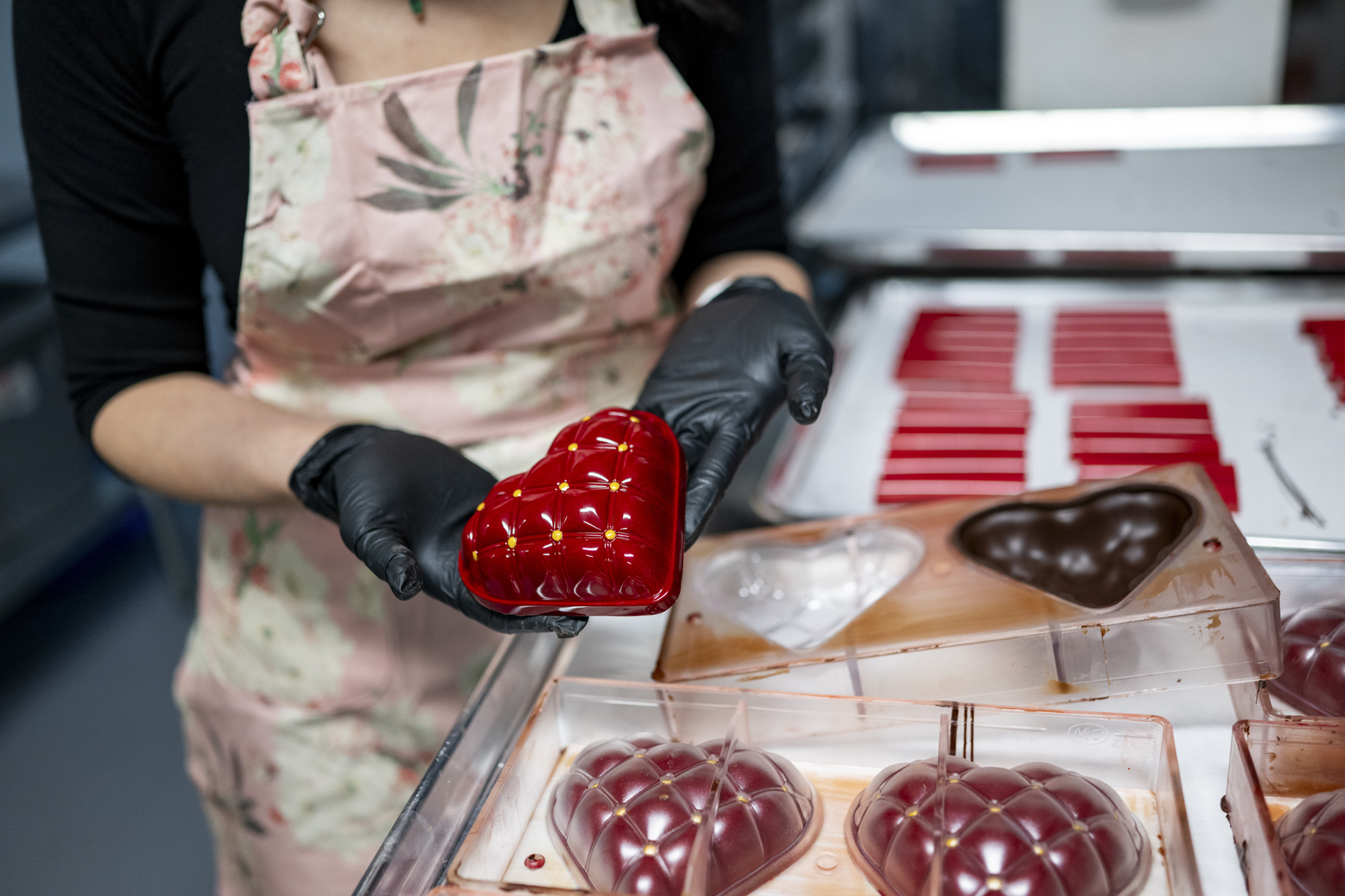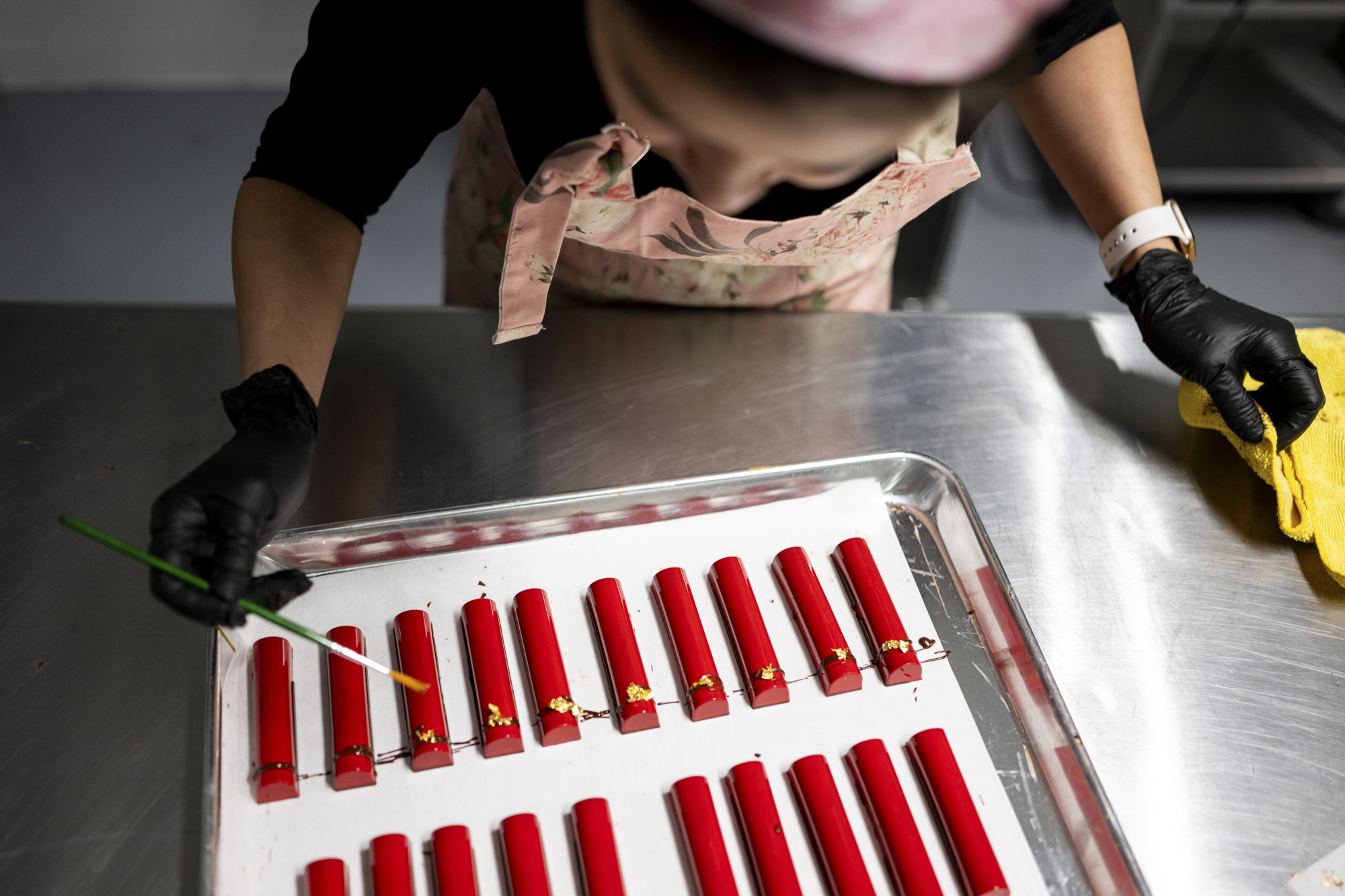Episode Transcript
Olivia Allen-Price: When you think of food and San Francisco, there are probably a few things that come to mind … sourdough bread from Boudin or Acme, maybe burritos in the Mission or dim sum in Chinatown. And then … there’s chocolate.
Relaxed piano music begins
Beth Caissie: Of course, I had heard of Ghirardelli chocolates, everybody, you know, it’s sort of synonymous with San Francisco.
Olivia Allen-Price: Beth Caissie moved to San Francisco in the middle of 2020.
Beth Caissie: I’m a newcomer here and I’m a geologist. I work for the US Geological Survey.
Olivia Allen-Price: And when she’s not collecting sediment cores from the Bering Sea — something she actually did this past summer — she’s probably eating chocolate.
Beth Caissie: I’m really into chocolate. I drink a mocha every single morning. And, you know, I feel like there’s two kinds of mocha drinkers. There’s like people who just like something sweet and then there’s people who really like chocolate. And I’m the chocolate variety.
Olivia Allen-Price: And she noticed San Francisco has a lot of chocolate makers.
Beth Caissie: It’s like everything from big chocolate makers like Ghirardelli and Guittard and then, you know, smaller ones like Dandelion. There’s like a guy who makes truffles in North Beach and there’s like a chocolate cafe in South Park. So I was like, oh, my gosh, what’s happening in San Francisco? Why are there so many chocolate makers? And my question really is like, does it have something to do with the Gold Rush?
Bay Curious theme music
Olivia Allen-Price: This is Bay Curious, the podcast that explores the Bay Area one question at a time. I’m Olivia Allen Price. Today, we’re going to dive into the rich Bay Area chocolate scene and understand why San Francisco’s history and location created the perfect conditions for chocolate makers — both then and now. Stay with us.
Sponsor message from Sierra Nevada Brewing Company
Olivia Allen-Price: To answer Beth Caissie’s question about what has made San Francisco such a notable chocolate town, we turn to — Reporter Adhiti Bandlamudi, who is quite the lover of chocolate herself…
Adhiti Bandlamudi: Our question-asker, Beth, is on the right track. The Gold Rush does have a part to play in the Bay Area’s chocolate scene. In many ways, the story of chocolate here is one of immigration and ingenuity.
Classic Italian lute music to set the scene
Adhiti Bandlamudi: The Gold Rush brought around 300,000 people to San Francisco in the mid-1800s from all over the world — and they were hungry. Domenico Ghirardelli and Etienne Guittard were two European immigrants who opened general stores to meet the need. They would go on to form two of the oldest and most iconic San Francisco chocolate companies. Maybe you’ve heard of them — Ghirardelli and Guittard.
Music ends
Greg D’Alesandre: Guittard and Ghiradelli started because they wanted to sell chocolate to people who were getting gold.
Adhiti Bandlamudi: Greg D’Alesandre is Dandelion Chocolate’s Chief Sourcing Officer.
Greg D’Alesandre: I sometimes go by chocolate sorcerer.
Adhiti Bandlamudi: And he says it makes sense that chocolate would come to San Francisco.
Greg D’Alesandre: Port cities were often the places where chocolate started and cocoa started because you had to get the beans here. The beans weren’t being grown here.
Adhiti Bandlamudi: East Coast port cities like New York and Boston also had new chocolate companies. But West Coast chocolate makers like Ghirardelli and Guittard set themselves apart by marketing their chocolate as a luxury product.
Greg D’Alesandre: Much the same way people did with coffee.
Old Ghirardelli Ad: “This Ghirardelli square is no ordinary chocolate… ”
Adhiti Bandlamudi: Big chocolate companies like Guittard and Ghirardelli got the ball rolling, making raw chocolate, from the cocoa bean into bars. It was only natural for other confectioners, or people who make things out of the chocolate, to open shop in the same area.
Greg D’Alesandre: A lot of people know See’s Candy. They use Guittard chocolate. Like they had a source of chocolate very nearby. And so it’s one of these things of like, you know like industries grow around the industries they need to support them.
Adhiti Bandlamudi: And here’s where San Francisco’s chocolate history gets really interesting. We had access to the cocoa beans through shipping. And old-school chocolate companies making high quality raw chocolate. But it’s the creativity and knowledge of San Francisco’s diverse population — folks from Europe, Asia, Latin America and beyond — that elevated those raw materials into truly magical chocolate treats. If you look at the many chocolatiers in the Bay Area today, many of them have built their businesses by putting their own cultural twist on chocolate.
Percussive music playing over the sound of a person scooping chocolate chips into a bowl
Adhiti Bandlamudi: I’m standing inside Socola, a chocolate shop in downtown San Francisco. Wendy Lieu, the founder of the company, opens huge boxes filled with Guittard chocolate chips — called “callets” — and scoops them into a bowl to start melting them down.
Scooping sound of chocolate chips continues
Adhiti Bandlamudi: She started Socola in 2001 with her sister, Susan.
Wendy Lieu: We were teenagers at the time, growing up in Santa Rosa. Our parents had a nail salon, so that meant every day after school, we’d go there to help out. And of course, we really didn’t enjoy doing that. We’d rather go across the street to the mall, and the first store in the mall was See’s Candies.
Adhiti Bandlamudi: Wendy and Susan tried all the samples and soon got used to the classic flavors of vanilla and chocolate buttercream, peanut butter, butterscotch — you know the drill. One day, Wendy decided to try making her own chocolate treats. She started with the bonbon, a chocolate shell with a ganache center.
Wendy Lieu: I found a recipe in Gourmet magazine for a mocha espresso chocolate. And I was instantly, like, enamored with chocolate and wanting to learn how to make it. Make more chocolates in more flavors.
Adhiti Bandlamudi: She and Susan started selling chocolate at their local farmer’s market stand. At first, they were making the same flavors they had seen at See’s Candies, but they felt like they were playing a game they’d never win.
Wendy Lieu: There’s going to be someone with better credentials and trained skills of like, ‘Oh, I, we trained with this person,’ and you know that for a chocolatier, that kind of sounds better.
Adhiti Bandlamudi: When they started, Wendy and Susan didn’t have all that fancy training. So the sister team decided to pivot. Farmer’s market customers were curious about the company’s name — Socola means chocolate in Vietnamese — and when they found out, they’d ask for Vietnamese flavors.
Wendy Lieu: Like, “Oh, make a coffee flavor.” And I was like “Well, that sounds interesting. But I also don’t want it to be boring. So can we make it Vietnamese coffee and add some condensed milk to it?”
Percussive music evoking creativity begins
And then we kind of just started doing that where someone was like, “Oh, make us spicy chocolate.” And I was like, “I won’t make chili, but I’ll make Sriracha.”
Adhiti Bandlamudi: A few years after that farmer’s market start in 2001, Socola started releasing bonbons with flavors like durian, passion fruit— even pho, like the Vietnamese soup.
Wendy Lieu: And then it was more fun and more interesting to come up with flavors that reflected our heritage. Right? So it was like, let’s make chocolates that flavors that don’t exist. And then no one can compare those.
Adhiti Bandlamudi: As I talk to Wendy, she hands me one of her latest creations: a pandan coconut bonbon.
Adhiti Bandlamudi (in tape): (crunch noise as she bites into chocolate) Mmm! Wow. The pandan is so subtle and yet it kind of hits you at the end.
Adhiti Bandlamudi: I can’t totally figure out how the chocolate flavors are working. Honestly, it’s just sorcery.
Adhiti Bandlamudi: In 2014, Socola hit a milestone, opening a brick-and-mortar shop in Rincon Hill.
Wendy Lieu: I feel a lot of happiness, representing our heritage and our culture and that, you know, we’re, you know, part of mainstream chocolate now. And before then, there were no other Vietnamese chocolatiers.
Music evoking the Lunar New Year
Adhiti Bandlamudi: San Francisco’s early chocolate makers were predominantly from European countries. But that’s slowly changing as pioneers like Wendy and Susan at Socola pave the way for more experimentation. In the last decades, the Bay Area has seen an explosion of new chocolatiers of color, many of them women, who are boldly playing with flavors in these bite-sized, edible pieces of art.
Fade in sounds from a visit to Formosa Chocolates
Kimberly Yang: This is toffee and black sesame and dark chocolate. And, just in the shape of a dragon for the Lunar New Year.
Adhiti Bandlamudi: That’s Kimberly Yang, a Taiwanese American chocolatier based in San Rafael. She owns the company Formosa Chocolates.
Kimberly Yang: Formosa is the old name for Taiwan. When the Portuguese sailors first saw the coastline, they said it was a beautiful island.
Adhiti Bandlamudi: Kimberly grew up in Oklahoma and, like so many first-generation immigrants, struggled to claim her cultural identity in such a different place.
Kimberly Yang: I didn’t have a lot of Taiwanese friends, let alone Asian friends.
Adhiti Bandlamudi: She became a psychiatrist and moved to the Bay Area for a job with Kaiser.
Kimberly Yang: When I moved to the Bay Area, I just started to notice that there’s more of this community
Adhiti Bandlamudi: Psychiatry was exhausting, so to get away from her stress, Kimberly took chocolate-making classes. She discovered a passion.
Kimberly Yang: It just got to the point where I was just feeling kind of burnt out with medicine, and I thought maybe try my hand at starting a chocolate company.
Sounds from Yang’s kitchen
Adhiti Bandlamudi: Kimberly’s industrial kitchen is vast and gleaming. She’s piping fine lines of chocolate onto her “Asian Twix bars” — one of her signature candies.
Kimberly Yang: Twix is one of my favorite candy bars to eat, and I think so many times customers ask, like, so what’s Taiwanese about your company? And mostly it’s me. I’m Taiwanese. But I thought I needed to lean more into Asian-inspired flavors. And I thought miso and caramel goes together so wonderfully. And I’ve been wanting to do more things with black sesame, so it’s just made it black sesame shortbread.
Adhiti Bandlamudi: Some of her other innovative flavors include balsamic vinegar caramel and strawberry bonbons shaped like an anatomically correct heart, gold-dusted bonbons with Taiwanese Kavalan whiskey and honey ganache. When she started the company in the fall of 2019 she was full of hope. Then the pandemic hit.
Kimberly Yang: Well, initially, I just had all this inventory on my hands and it’s like, oh, gosh, there’s nothing more depressing than a chocolatier with nobody to sell their chocolates to.
Adhiti Bandlamudi: She had to find a way to sell directly to consumers. That meant setting up her own website, figuring out how to ship chocolate across the country without it melting or breaking, marketing and customer service.
Kimberly Yang: I’m the one doing that and it’s not as intuitive as you would think.
Percussive music evoking hitting one’s stride
Adhiti Bandlamudi: But eventually Kimberly found a rhythm. She became known for her limited edition Lunar New Year boxes. The Michelin Guide featured Formosa Chocolates, and Bon Appetit Magazine included them in a list of “The Best Chocolates To Buy Online.” Kimberly must have been doing something right because last year, the State Department asked her to make chocolates for the APEC Summit.
Kimberly Yang: The ordering went through, and so we made 3,300 boxes of bonbons for the dignitaries. I don’t think I’ll ever get such a big order again. That was a lot. I mean, and it’s good to know that I can handle it. laughs
Adhiti Bandlamudi: Kimberly plans to keep experimenting. She’d like to try making chocolates that aren’t even sweet but instead play with spicy or umami flavors. And she’s confident that in the Bay Area, at least, there will be people who will want to try them. She’s got the Mid-Autumn Festival Mooncake bonbons to prove it.
Kimberly Yang: Growing up, like, I don’t think most people knew what mooncakes were. And maybe most people in America don’t know what mooncakes are, but people in the Bay Area do. It’s really interesting. And it’s nice to not have to explain all of that to people.
Adhiti Bandlamudi: Because in the Bay Area — there’s room for it all: classic bonbons with caramel and raspberry fillings, ganache flavored with pandan, pho or miso. And whatever new invention comes next.
Adhiti Bandlamudi: In many ways, the story of chocolate in the Bay Area is the story of the Bay Area. Lots of people from different places coming together, infusing the tastes and textures of their cultures into everything around them.
Relaxed, positive electronic piano music
Olivia Allen-Price: That was KQED reporter Adhiti Bandlamudi. Thanks to Beth Caissie for asking this week’s question. Have you voted in our February public voting round yet? Here are the questions we’re considering…
Anonymous voice 1: When I visit the Great Mall in Milpitas, I see some signs/plaques within the mall commemorating the Ford Motor Company plant that used to be on that same site. What’s the story behind this former plant?
Anonymous voice 2: What is at the bottom of the bay and is there any treasure down there?
Anonymous voice 3: How are canned/jarred artichoke hearts made? What happens to all the outside leaves? Just how many artichokes are grown in California?
Olivia Allen-Price: Head to BayCurious.org and cast your vote. You don’t need to sign up or login or anything — just click! It’s so easy. And while you’re there check out the Bay Curious archive for any interesting episodes you may have missed.
Olivia Allen-Price: Bay Curious is made by Katrina Schwartz, Christopher Beale, and me, Olivia-Allen Price. Additional support from Jen Chien, Katie Sprenger, Cesar Saldana, Maha Sanad, Holly Kernan and the whole KQED Family.
